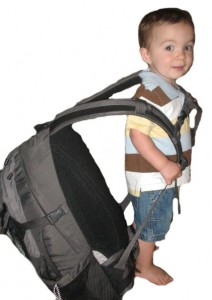 It’s that time of year, back to school! The kids will need new notebooks, pens, markers, erasers, and books. How will they carry those supplies around all day and to and from school? The most common choice is a backpack. The pack you choose for your child should have certain features and be used properly to minimize the stress to your child’s spine.
It’s that time of year, back to school! The kids will need new notebooks, pens, markers, erasers, and books. How will they carry those supplies around all day and to and from school? The most common choice is a backpack. The pack you choose for your child should have certain features and be used properly to minimize the stress to your child’s spine.
Some studies have shown that up to 50% of adolescents experience back or neck pain and improper use of backpacks may contribute to that pain. There are laws that protect adult workers from carrying too much weight but no laws protecting our kids! The amount of weight children are expected to carry around on a daily basis is ever increasing and happening at a younger age. So how do you protect your child’s spine?
The first thing to try and control is the amount of weight carried. Studies have reported some students carry almost 30% of their weight in a pack! The total weight of the backpack should be 10% to 15% of your child’s body weight. Younger, smaller children are more affected by the weight carried so they should be closer to the 10% limit. Using a locker can decrease the amount that needs to be carried throughout the day. At the end of the day make sure your child is bringing home only what they need for that evening.
The style of the backpack and how it is carried and loaded are also very important. When shopping for a backpack there are a number of features to look for. The shoulder straps should be well padded, curved and adjustable to conform to the body. The back of the pack should also be padded to prevent pressure points on your child’s back while they are carrying it. A pack with multiple compartments will allow you to distribute the load evenly and keep everything organized which prevents carrying extra, unnecessary items. Compression straps on the inside or outside hold the items tight so they are not moving around in the pack.
When loading the pack use the same rules hikers use when they are carrying their packs for days at a time. Put the heaviest items in first and close to your back. Start with the heavy textbooks and notebooks, then put in the smaller books, note cards etc. Avoid putting anything heavy at the top of the pack or on the outside. Those areas should be reserved for something light like a jacket at the top or pens and pencils in the outer part. Now that the pack is loaded properly it should be centered over and fit snuggly against your child’s back. Feel along your side until you hit the top of your pelvis and draw a straight line around to your back. This marks the top of your pelvis and where the bottom of the pack should sit.
Extremely important is how the pack is carried. Your child should always use both shoulder straps at the same time. Even when both straps are used it causes postural changes. A backpack carried on both shoulders will cause the trunk to bend forward, and make the wearer stick their head out forward. If the pack is carried on only one shoulder the postural changes are much greater. The lopsided load now causes the shoulder it is carried on to elevate and shift backward and the trunk shifts to the side away from the load. This is the body’s response to the uneven load and trying to maintain its center of gravity. The greater the load and the longer it is carried only increase these postural shifts. One way to avoid stressing the spine at all is to use a pack that has wheels. Many packs are now available that work just like a regular pack but have wheels on the bottom, with a retractable handle on top, and allow you to just roll it along behind you and not have to carry it all. This is the best choice if your child has to carry a lot of weight.
Carrying heavy loads for long periods of time can cause damage to the discs, ligaments, and joints of the spine. Protect your child’s spine with a quality backpack that is loaded and carried properly. If you notice changes to your child’s posture or they are complaining of pain get them to a Chiropractor to get checked!